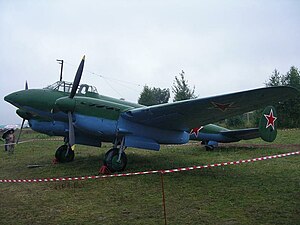Petlyakov Pe-2
| Pe-2 | |
|---|---|
 |
|
| Role | Bomber |
| Manufacturer | Petlyakov |
| Designer | Vladimir Petlyakov |
| First flight | 22 December 1939 |
| Introduction | 1941 |
| Retired | 1954 (SFR Yugoslav Air Force) |
| Primary users |
Soviet Air Force SFR Yugoslav Air Force Air Force of the Polish Army Czechoslovakian Air Force |
| Number built | 11 427 |
| Variants | Petlyakov Pe-3 |
The Petlyakov Pe-2 (Russian: Петляков Пе-2) was a Soviet light bomber used during World War II. It was regarded as one of the best ground attack aircraft of the war and it was successful in the roles of heavy fighter, reconnaissance and night fighter. It was similar in many respects to the British de Havilland Mosquito. Pe-2s were manufactured in greater numbers (11,427 built) during the war than any other twin-engined combat aircraft except for the German Junkers Ju 88 and British Vickers Wellington. The Pe-2 was fast, maneuverable and durable. Several Communist nations flew the type after the war, when it became known by the NATO reporting name Buck. Six captured Pe-2s were also transferred from the Germans to the Finnish Air Force during the Continuation War, with the serial code PE- and the unofficial nickname Pekka-Eemeli.
The Pe-2 was designed in a prison design bureau (sharashka); Vladimir Petlyakov had been arrested and imprisoned in 1937 for allegedly delaying design work on the Tupolev ANT-42 bomber. In the sharashka, Petlyakov was put in charge of a team to develop a high-altitude fighter escort for the ANT-42 under the designation VI-100. The first of two prototypes flew on December 22, 1939 and was a sophisticated aircraft for its time, featuring a pressurised cabin, all-metal construction, superchargers and many electrically actuated systems. It is said that Petlyakov and his team could see the VI-100 prototype from their prison as it was put through its paces for the crowds watching the annual May Day parade in 1940.
Just as production was ready to begin, the air force ordered a re-design of the aircraft. The value of tactical bombing had just been displayed by the Luftwaffe in the Blitzkrieg, and the need for such an aircraft suddenly became much more important than the need for a high-altitude escort fighter. Petlyakov's team was given 45 days to redesign their aircraft as a dive bomber. Cabin pressurization and superchargers were deleted, dive brakes and a bombardier's position were added, and other aerodynamic refinements. A fuselage bomb-bay was added, along with smaller bays in each engine nacelle. The aircraft was initially designated PB-100, but Joseph Stalin was impressed enough with Petlyakov to free him, and his name was permitted to be used in the aircraft's designation. The first aircraft flew on December 15, 1940, rushed through production without a prototype under severe threats from Stalin. Deliveries to combat units began the following Spring.
...
Wikipedia
